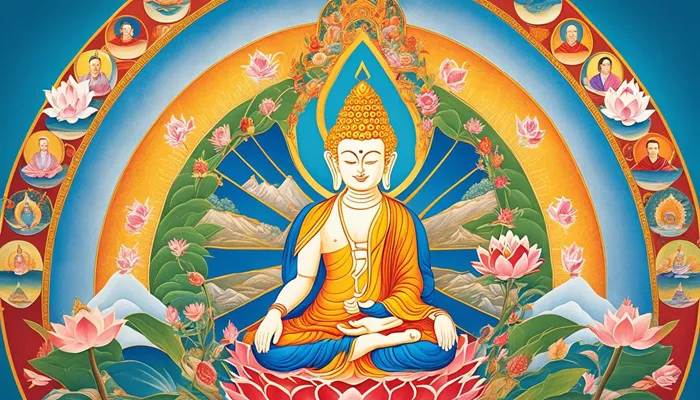Many people new to Buddhism wonder, “Did Mahayana come after Theravada?” The answer is yes. Mahayana Buddhism developed after Theravada Buddhism. Both are major branches of Buddhism, but they emerged in different historical periods and reflect different views and practices. In this article, we will explore the timeline, origin, and development of these two schools in simple language for better understanding.
What is Theravada Buddhism?
Theravada Buddhism is considered the oldest surviving school of Buddhism. It focuses on the original teachings of the Buddha and aims to preserve them as closely as possible. The word “Theravada” means “Teaching of the Elders.”
It is based on the Pali Canon, a collection of scriptures in the Pali language. This tradition emphasizes personal meditation and ethical living to achieve enlightenment, called Nirvana. Theravada Buddhists believe that becoming an Arhat — someone who has attained enlightenment — is the highest spiritual goal.
If you are curious about the Theravada Buddhism origin, it dates back to around the 3rd century BCE, after the third Buddhist council held by Emperor Ashoka in India.
Theravada Buddhism History
Theravada Buddhism spread from India to Sri Lanka around 250 BCE. From there, it traveled to countries like Thailand, Myanmar (Burma), Laos, and Cambodia. These countries still practice Theravada as their main form of Buddhism today.
Over time, the teachings were preserved in monasteries and passed down through generations. The focus has remained on monastic discipline, meditation, and individual liberation.
What is Mahayana Buddhism?
Mahayana means “Great Vehicle.” It is a later development in Buddhist history. Mahayana Buddhists believe in helping all beings achieve enlightenment, not just focusing on individual liberation.
This school teaches that everyone has the potential to become a Buddha, not just monks or advanced practitioners. Mahayana also introduces the idea of the Bodhisattva — a person who delays their own enlightenment to help others reach the path.
Mahayana scriptures are written in Sanskrit and include many new texts not found in the Pali Canon. These texts explain advanced philosophical ideas and new practices like compassion and universal wisdom.
When Did Mahayana Buddhism Start?
Mahayana Buddhism appeared around the 1st century CE, several centuries after Theravada had already spread across South and Southeast Asia. It began in India and quickly spread to Central and East Asia, including China, Korea, Japan, and Vietnam.
The Shift from Theravada to Mahayana
As Buddhism grew, different ideas started to develop. Some followers felt that the early teachings were too strict or limited. They wanted a broader path that welcomed laypeople and focused more on compassion and helping others. This led to the birth of Mahayana.
So, yes — Mahayana came after Theravada. But it wasn’t meant to reject the earlier teachings. Instead, it built upon them, offering a new way to practice the Dharma (Buddha’s teachings).
Key Differences Between Theravada and Mahayana
1. Goal of Practice
In Theravada, the main goal is to become an Arhat, someone who has escaped the cycle of birth and death. In Mahayana, the goal is to become a Bodhisattva and eventually a Buddha, helping all sentient beings along the way.
2. Scriptures
Theravada uses the Pali Canon, while Mahayana uses the Mahayana Sutras written in Sanskrit. These include texts like the Lotus Sutra and the Heart Sutra.
3. View on the Buddha
Theravada sees the Buddha as a wise human teacher. Mahayana often views him as a transcendent being with limitless qualities who still helps beings in other realms.
4. Monastic vs. Lay Participation
Theravada focuses more on monastic life. Mahayana encourages both monks and laypeople to follow the path and even become Bodhisattvas.
Why Did Mahayana Develop?
As Buddhism spread and more people became involved, the needs of the followers changed. Not everyone could live as a monk. Many wanted to practice the Dharma while living a regular life. Mahayana teachings offered a more flexible path. It allowed laypeople to grow spiritually and work toward enlightenment in their own ways.
New Teachings and Philosophy
Mahayana introduced several new ideas:
- Sunyata (Emptiness): Everything is empty of a separate self. This idea goes beyond the concept of no-self in Theravada.
- Compassion: Practicing love and kindness for all beings is central.
- Bodhisattva Ideal: Putting others before oneself is the highest virtue.
Common Misunderstandings
Some people think Mahayana replaced Theravada. This is not true. Both exist today and are practiced by millions. They are not in competition. Instead, they are two ways of walking the same spiritual path.
Others believe Mahayana is more “modern.” While it came later in history, it still carries deep ancient wisdom. It simply took the Dharma in a broader direction to include more people.
Similarities Between Theravada and Mahayana
Despite their differences, both schools share core teachings:
- The Four Noble Truths
- The Eightfold Path
- Karma and Rebirth
- The goal of ending suffering
They also honor the historical Buddha and aim to reduce greed, hatred, and ignorance.
Modern Practices Around the World
Today, Theravada is mainly practiced in Sri Lanka, Thailand, Myanmar, Laos, and Cambodia. Mahayana is popular in China, Japan, Korea, Vietnam, and Tibet (though Tibet often follows Vajrayana, which is rooted in Mahayana).
In the West, both traditions have spread widely. People appreciate Theravada’s focus on meditation and mindfulness. Others are drawn to Mahayana’s emphasis on compassion and universal enlightenment.
Conclusion
Yes, Mahayana did come after Theravada. Theravada preserved the earliest teachings of the Buddha. Mahayana developed later, offering a broader and more inclusive path. Both paths have deep wisdom and beauty. They help people live better lives and understand the true nature of the world.
Whether one chooses Theravada or Mahayana, the heart of Buddhism remains the same — awakening from ignorance and helping others do the same.

